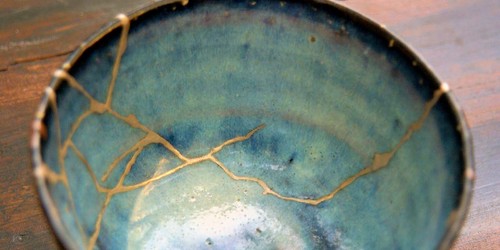 By repairing broken ceramics it’s possible to give a new lease of life to pottery that becomes even more refined thanks to its “scars”. (Photo: lifegate.com) By repairing broken ceramics it’s possible to give a new lease of life to pottery that becomes even more refined thanks to its “scars”. (Photo: lifegate.com) |
In the Japanese language “kin” means gold and “tsugi” is repair and kintsugi is a way to repair broken pottery with lacquer dusted or mixed with powdered gold, silver, or platinum.
One theory is that Kintsugi dates back to the late 15th century when Japanese shogun Ashikaga Yoshimasa, sent a damaged Chinese tea bowl back to China for repair.
When it was returned, Yoshimasa was disappointed to find the item repaired with ugly metal staples, and asked his craftsmen to find a more refined mending solution. The final result was aesthetically pleasing and kintsugi arose as a practical, albeit expensive, way to fix a broken object.
It has grown steadily for 500 years.
Artisan Kuroda Yukiko who lives in Chiba prefecture about 2 hours from Tokyo, said, “Western methods seem to be about hiding imperfection. A piece with obvious flaws is seen as no good. But to me, the blemishes, the lines made by cracks are beautiful.”
In the art of kintsugi, blemishes are considered part of the work and valued as part of the item’s history.
As a philosophy, kintsugi is similar to the Japanese philosophy of wabi-sabi, an embracing of the flawed or imperfect.
The art form seems to say that if such incredible beauty can emerge from the broken pieces of a vase, a similar transformation can be made with humans.
Artisan Kuroda says when she restores broken pieces, she seems to forget all sadness.
“My mind is free of distraction and I forget all my worries. It’s a feeling of true bliss. I suddenly notice I’m not thinking of anything at all. I’m restoring a piece of pottery but I’m also restoring myself,” Kuroda confided.
There are three methods of kintsugi. The first and the most basic method is to reassemble with urushi lacquer, the sap of the urushi tree. In this method, the broken pieces are reassembled, with a minimal overlap. A gold dust is then applied which fixes to the lacquer and gives the cracks a golden hue.
Sometimes part of the ceramic is missing, so the gap is filled in with a mixture of lacquer and gold. This is the second method.
But mending ceramics with gold can go even further. In the third and most intricate method, the craftsman will take a piece from another ceramic. This piece is inserted to create a patchwork effect, enhancing the object richness and history.
Kintsugi is a slow process because urushi lacquer requires a long time to harden. It can sometimes take weeks and it requires a dry environment to harden properly.
Modern kingtsugi provides quicker ways to repair ceramics. New methods can shorten the time to 30 minutes.
Yoko Nakazawa, a Japanese miso expert, explains the new approach, “Now we use synthetic glue …slow drying glue is best. It’s stronger and gives you a chance to fix a mistake. If you use lacquer, you can do it as many times as you like. If you don’t like something, you can do it again."
"With this modern technique, it’s quite quick. Using a slow-drying glue gives you a little bit more opportunity. If you use it for cups and plates for food, make sure you use a food-safe grade of glue. Otherwise use the modern kintsugi technique only for flower pots and accessories or things you don’t put your mouth on,” said Yoko.
Kintsugi has been booming in recent years and has spread beyond Japan to the rest of the world. Now, when an object breaks, it doesn’t necessarily lose its usefulness. Its flaws can make it more valuable. Repairing things can sometimes give us more valuable objects.
This is the essence of sustainability!